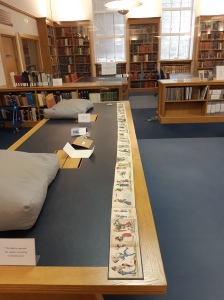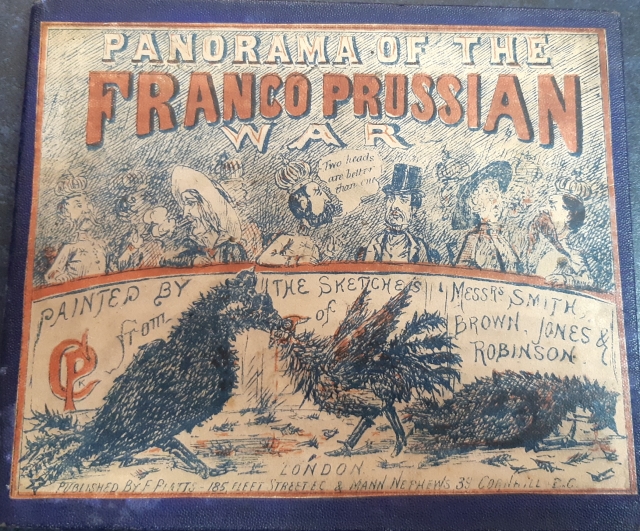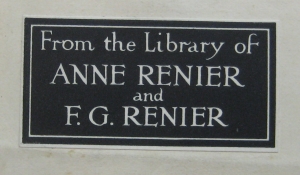We are delighted to be able to shed light on the recent purchase by Cambridge University Library Special Collections of a satirical Panorama of the Franco-Prussian war. Illustrated by Percy Cruikshank, it probably dates from the end of 1870. It relates to both the exhibition of the Cambridge collection of 1870-71 caricatures held at the University Library this spring, and the academic conference on the Memory of 1870-71 held at Wolfson College by Marion Glaumaud-Carbonnier and Nick White last month.
 The Panorama of the Franco-Prussian war, published in London by F. Platts & Mann Nephews, was “painted by PC from the sketches of Messrs. Smith, Brown, Jones & Robinson”. The full signature of Percy Cruikshank (1817-1880) appears repeatedly within the images themselves. Percy came from an illustrious family of caricaturists: he was the son of Isaac Robert Cruikshank (1789-1856), the nephew of George Cruikshank (1792-1878), and the grandson of Isaac Cruikshank (1764-1811). He contributed caricatures of the Franco-Prussian war to the British satirical humour magazine Judy or the London Serio-Comic Journal (named after Punch and Judy). The highly collaborative nature of the panorama is interesting given the reference to no less than four sketchers.
The Panorama of the Franco-Prussian war, published in London by F. Platts & Mann Nephews, was “painted by PC from the sketches of Messrs. Smith, Brown, Jones & Robinson”. The full signature of Percy Cruikshank (1817-1880) appears repeatedly within the images themselves. Percy came from an illustrious family of caricaturists: he was the son of Isaac Robert Cruikshank (1789-1856), the nephew of George Cruikshank (1792-1878), and the grandson of Isaac Cruikshank (1764-1811). He contributed caricatures of the Franco-Prussian war to the British satirical humour magazine Judy or the London Serio-Comic Journal (named after Punch and Judy). The highly collaborative nature of the panorama is interesting given the reference to no less than four sketchers.
Panoramic paintings became popular in Europe in the late 18th and 19th centuries, following the work of the painter Robert Barker, who created panoramas of Edinburgh and London, and whose rotunda at Leicester Square was a huge commercial success. Panoramas included cityscapes but also landscapes and battle scenes, especially at the time of the Napoleonic wars. They were often dozens or hundreds of meters long, or even more, and provided popular (and lucrative) forms of education and entertainment. Many large-scale painted panoramas of the Franco-Prussian war and the Siege of Paris (hundreds of meters long) were produced and circulated in the UK, Australia and New Zealand, France, Europe and the United States, from 1870 to the 1890s. Cruikshank’s Panorama of the Franco-Prussian war is only 12.5 cm high, though it does measure more than 3 meters and hardly fits on our large items Rare Books Reading room table! It folds down to a concertina book of 13 x 15 cm, a ‘pocket’ format which means it was probably intended for the personal use of a private collector, rather than for public display.

The work is original because it combines ingeniously the form of the panorama with the genre of satire. It features caricatures of famous individuals (Wilhelm I, Bismark, Napoleon III, Moltke, McMahon, prince Eugène-Louis Napoléon, Bazaine, Victor Hugo…), as well as more generic satirised figures (French (colonial) troops, French Republicans / revolutionaries…). Cruikshank’s Panorama is more than a single-page sum of individual caricatures or comic strip, and differs from a large satirical group portrait such as the Panthéon Nadar (1851). It develops as a sequential comic strip in an accordion fold-out. Cruikshank had previously created other folded lithographic comic panoramas inspired by contemporary history: he illustrated ‘Guy Faux: a Squib’ by Horace Mayhew (1849), and authored ‘The Comic History of the Russian War’ [c.1856], and ‘The Comic History of the Potentates of the World’ [n.d.].
The Franco-Prussian war panorama’s cover, printed in blue and red ink, shows an assembly of kings and leaders gathering to watch a bloody birds’ fight in a pit. The German double-headed eagle, in spiked helmet, is grabbing the head of the French rooster, bearing a Phrygian hat with a tricolour rosette. He has already vanquished the French imperial eagle. King Edward VII tells his neighbour, the American President Ulysses S. Grant: “Two heads are better than one”.
The panorama starts with the origins of or pretext for the Franco-Prussian war: the candidacy of a Prussian prince for the throne of Spain (after the Revolution of 1868 and the deposition of Queen Isabella II) is featured with Wilhelm I, then King of Prussia, offering to Spain, featured as a little child, “a German doll”. The move was opposed by France who (fearing encirclement) optimistically declared war. However, the French army (its colonial troops, depicted with racial stereotypes, featuring prominently in the panorama) was quite unprepared and soon experienced the superiority of the Prussian army.
The comic develops the satirical account of the war through the running metaphor of France inviting itself to Germany, and of the welcome it received: Bismarck “prepare[s] a series of [cannon] balls, to be followed by a grand rout”… “His Imperial Majesty [Napoleon III] is entertained in Sedan” [by a grand dinner which blows up in his face]. The defeated Napoleon III goes into exile in Germany: “Being in reduced circumstances, with not half-a crown left, he requests his ‘Dear brother’ to get a lodging for him”.
Next, the Republican and revolutionary French “demolish the Empire”, destroying statues of Napoleon III, active not only in Paris but also in the provinces –including Lyons, where they “establish a model government”, debating around a table featuring a miniature guillotine… Victor Hugo, who came back from Guernsey shortly after the defeat of Sedan (he had gone into exile after the coup d’état of 2 December 1851 by the then president Louis-Napoléon Bonaparte), is featured caring for children while making “his touching [but ineffective] appeal to Prussia” in favour of peace. Trochu, the new president of the French Government of National Defence, who unsuccessfully managed the defence of Paris besieged by the Prussians, is ridiculed, along with the absurd and self-destructive French military strategy of cutting down forests ahead of Prussian advances.
Paris, under the blockade, is famished, with a “Provision-all Government having undertaken to supply the city”. The strip includes depictions of the postal balloons used during the siege, and of the [soon to be sold and eaten] exotic animals of the Jardin des Plantes. The depiction of abuses committed by the Prussians suggests a pro-French perspective. Prussia, embodied by its Emperor, having dealt with the French imperial eagle, is still inconvenienced by the Parisian rooster. “Having already settled one bird, he determines to bag the other, and ‘cook him in his own gravy’”.
 The end of the comic is revealing because, while it finishes on the funeral of France, it does not portray Wilhelm as a victor, but as a sick man getting ready for bed. It does not feature the proclamation of Wilhelm as German Emperor on 18 January 1871 at Versailles, nor the subsequent armistice and its conditions. This helps date the panorama to the end of 1870 or the early days of 1871.
The end of the comic is revealing because, while it finishes on the funeral of France, it does not portray Wilhelm as a victor, but as a sick man getting ready for bed. It does not feature the proclamation of Wilhelm as German Emperor on 18 January 1871 at Versailles, nor the subsequent armistice and its conditions. This helps date the panorama to the end of 1870 or the early days of 1871.
This copy of Cruikshank’s panorama of the Franco-Prussian war, recently purchased by Cambridge University Library, contains the bookplate of Anne (1911?-1988) and Fernard Gabriel Renier (1905-1988). This panorama is one of the items dispersed from the Reniers’ library. These bibliophiles donated their collection of children’s literature (containing over 80,000 books plus toys, games and printed ephemera) to the Victoria and Albert Museum in 1970. Their William Hone Manuscript Collection is now at the Adelphi University Library in New York. William Hone (1780-1842) was a printer, parodist, antiquarian, and publisher who had collaborated with George Cruikshank on the production of illustrated satirical pamphlets between 1819 and 1821.
The copy of the Panorama of the Franco-Prussian war acquired by Cambridge UL is, as far as we know, the only one held in a UK library. You can come and examine it in the Rare Books reading room (8000.e.354), or consult on the Internet Archive the version digitised by the McGill University Library in Montreal (though parts of their copy are obscured by library labels).
Irene Fabry-Tehranchi





